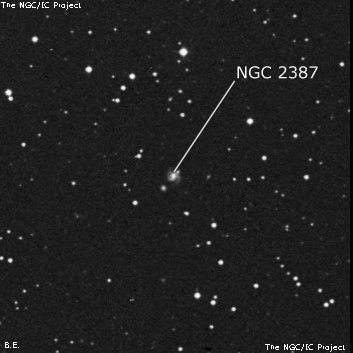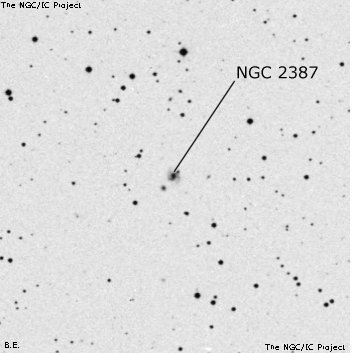NGC/IC Project Restoration Effort
(This is a very very beta version)
NGC2387


Basic Information
Location and Magnitude
Right Ascension: 7:29:26.1
Declination: +36:46:8
Constellation: AUR
Visual Magnitude:
Historic Information
Discoverer: Herschel W.
Year of discovery: 1790
Discovery aperture: 18.7
Observational
Summary description: pB, S, stellar
Sub-type: *2
Corwin's Notes
=====
NGC 2387 is probably a double star. For decades, we have taken it as the
faint spiral seen by Dreyer with LdR's Leviathan, CGCG 177-023 =
CGCG 0725.6+3658. The galaxy, however, is over 8 arcmin north of the NGC
position.
I finally became suspicious of this in February 2014 looking at WH's
description "pB, S, stellar" -- this clearly does not match the faint galaxy.
Reducing WH's position from his offsets (7m 22s following, 0d 01' north of 65
Aurigae) revealed an error in the NGC RA of over 15 seconds of time (about 3.5
arcmin), and put WH's position within 1.5 arcmin of a double star. This is
considerably brighter than the faint galaxy, and generally fits his
description much better. The double star may well be the object WH saw on 10
March 1790. It's worth noting that WH has this comment in his observation:
"The wind too high to verify it." Poor seeing often accompanies high winds,
so the double star could have appeared nebulous under these conditions.
Wolfgang suggests that the 12th magnitude star northwest of Herschel's
position might be the correct object. This, too, is a possibility, so I've
listed it in the big position table, though with a question mark.
Steve's Notes
=====
NGC 2387
24" (2/22/14): at 125x, this 7" double star generally appeared as an unresolved quasi-stellar glow and it was easy to see how it could be mistaken as a possible nebula. At 200x, it was often cleanly resolved, but still the fainter companion is dim enough to often appear not as a sharp star, but a very faint "appendage" to the brighter component, mimicking a tiny nebula. Also, there are 3 mag 15-16 stars closeby [within 25"] that perhaps contribute to noticing this pair. At 260x and above, the pair was nearly always resolved cleanly.
CGCG 177-023, the galaxy identified as NGC 2387 in the CGCG, RNGC and PGC, appeared very faint, small, round, low even surface brightness, 15" diameter. An extremely faint companion 25" SE was not seen.



